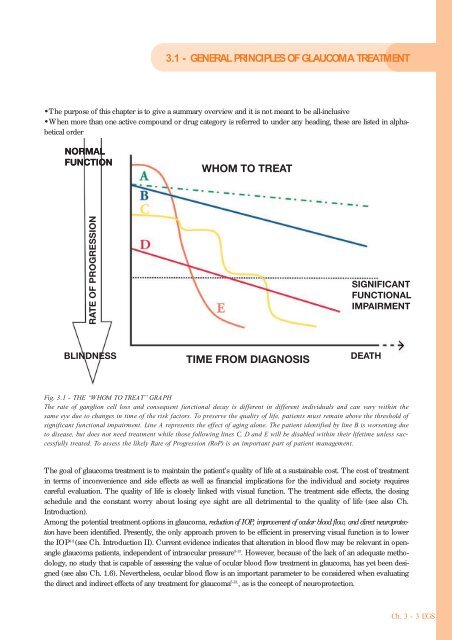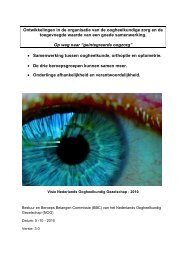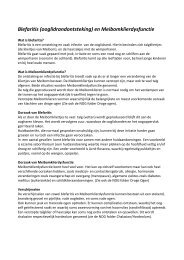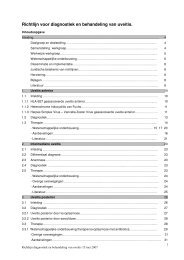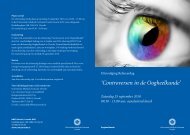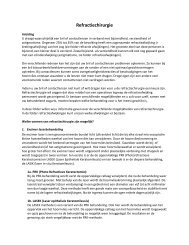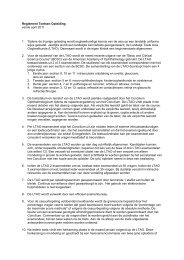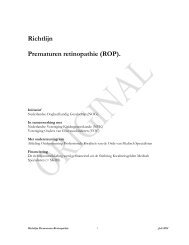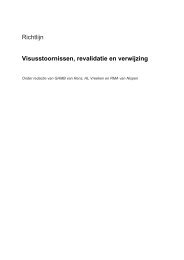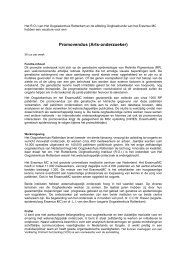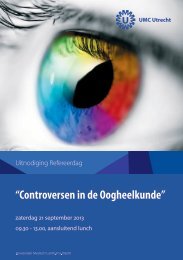terminology and guidelines for glaucoma ii - Kwaliteitskoepel
terminology and guidelines for glaucoma ii - Kwaliteitskoepel
terminology and guidelines for glaucoma ii - Kwaliteitskoepel
Create successful ePaper yourself
Turn your PDF publications into a flip-book with our unique Google optimized e-Paper software.
3.1 - GENERAL PRINCIPLES OF GLAUCOMA TREATMENT<br />
• The purpose of this chapter is to give a summary overview <strong>and</strong> it is not meant to be all-inclusive<br />
• When more than one active compound or drug category is referred to under any heading, these are listed in alphabetical<br />
order<br />
NORMAL<br />
FUNCTION<br />
WHOM TO TREAT<br />
RATE OF PROGRESSION<br />
SIGNIFICANT<br />
FUNCTIONAL<br />
IMPAIRMENT<br />
BLINDNESS<br />
TIME FROM DIAGNOSIS<br />
DEATH<br />
Fig. 3.1 - THE “WHOM TO TREAT” GRAPH<br />
The rate of ganglion cell loss <strong>and</strong> consequent functional decay is different in different individuals <strong>and</strong> can vary within the<br />
same eye due to changes in time of the risk factors. To preserve the quality of life, patients must remain above the threshold of<br />
significant functional impairment. Line A represents the effect of aging alone. The patient identified by line B is worsening due<br />
to disease, but does not need treatment while those following lines C, D <strong>and</strong> E will be disabled within their lifetime unless successfully<br />
treated. To assess the likely Rate of Progression (RoP) is an important part of patient management.<br />
The goal of <strong>glaucoma</strong> treatment is to maintain the patient’s quality of life at a sustainable cost. The cost of treatment<br />
in terms of inconvenience <strong>and</strong> side effects as well as financial implications <strong>for</strong> the individual <strong>and</strong> society requires<br />
careful evaluation. The quality of life is closely linked with visual function. The treatment side effects, the dosing<br />
schedule <strong>and</strong> the constant worry about losing eye sight are all detrimental to the quality of life (see also Ch.<br />
Introduction).<br />
Among the potential treatment options in <strong>glaucoma</strong>, reduction of IOP, improvement of ocular blood flow, <strong>and</strong> direct neuroprotectionhave<br />
been identified. Presently, the only approach proven to be efficient in preserving visual function is to lower<br />
the IOP 1-2 (see Ch. Introduction II). Current evidence indicates that alteration in blood flow may be relevant in openangle<br />
<strong>glaucoma</strong> patients, independent of intraocular pressure 3-13 . However, because of the lack of an adequate methodology,<br />
no study that is capable of assessing the value of ocular blood flow treatment in <strong>glaucoma</strong>, has yet been designed<br />
(see also Ch. 1.6). Nevertheless, ocular blood flow is an important parameter to be considered when evaluating<br />
the direct <strong>and</strong> indirect effects of any treatment <strong>for</strong> <strong>glaucoma</strong> 5-13, , as is the concept of neuroprotection.<br />
Ch. 3 - 3 EGS


